#234: Mushroom Development
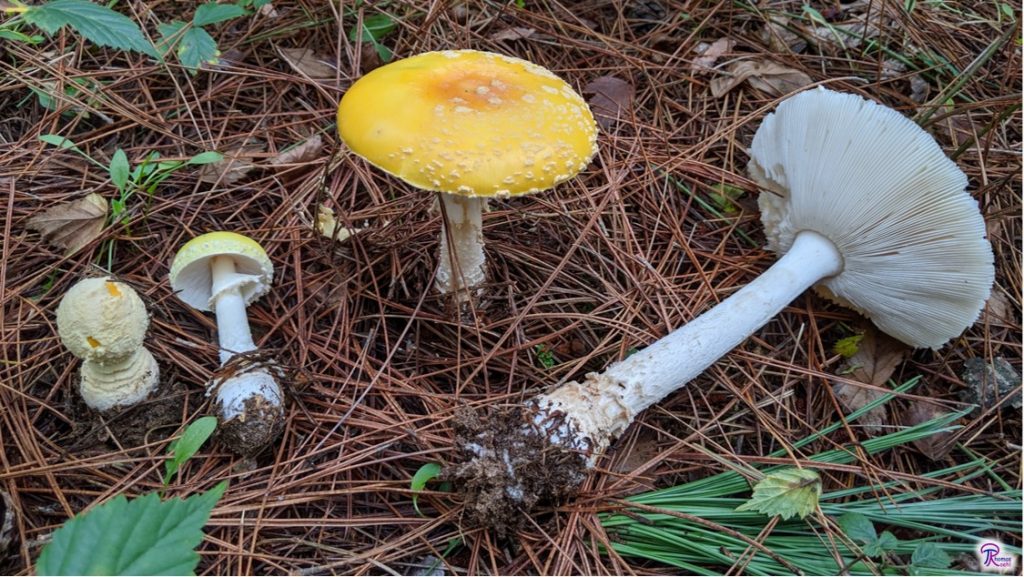
My first introduction to mushrooms was as a child seeing them appear as if by magic in my family’s lawn. This mysterious way that fungi appear to pop into existence still captures my imagination, which brought me to the small but interesting field of mushroom development. So, can science explain how mushrooms appear out of thin air? Mostly, but there is still much we don’t know. Obviously, mushrooms don’t materialize out of nothing – instead, they sprout from the mycelium already growing in the substrate. Typically, this proceeds as follows: the mycelium bunches up, then the various mushroom tissues are created, and finally whole fruitbody gets larger. However, this generalized model has limitations and can’t explain all the variation we see in mushroom shapes.
Why Study Mushroom Development?
Before we get into the details, it is useful to discuss why mushroom development should be studied. One of the major reasons to study mushroom development is to learn more about how mushrooms evolved. Fungal fruitbodies are fleshy and therefore don’t fossilize well. There are a few mushroom fossils (see FFF#010), but these already have gills and look remarkably like modern mushrooms. As a result, we need to use other methods to figure out how fungi evolved specialized structures for spore release. Studying how developmental elements evolved can help fill in the gaps in the fossil record. This improved understanding of evolution will in turn benefit taxonomy (because our naming system is designed to reflect evolutionary history).
Studying development will also improve our knowledge of mushroom cell biology. A lot of work has been done on cell biology in fungi, but most focuses on hyphae and yeasts. Mushrooms are structured very differently and need to solve different problems: the cells are packed together into tissues and must tightly coordinate their actions. The proteins, genes, cellular structures, and communication methods that fungi use specifically in multicellular structures haven’t received as much study and are still largely unknown.
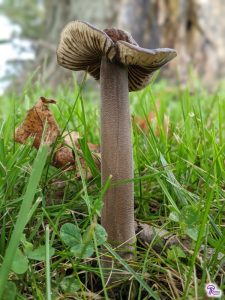
There is also an economic incentive to study mushroom development; mushroom cultivation is a large global industry which, after all, relies completely on proper fruitbody development. Development-related research that has already been done for commercial reasons includes: identifying sporeless mutations (fewer spores means fewer respiratory problems for mushroom pickers), characterizing mycoviruses that alter development (such as La France Disease in Agaricus bisporus), and using genetic engineering to prevent browning in A. bisporus. Further research into mushroom development could provide other advantages, such as finding ways to more precisely trigger fruiting or grow larger mushrooms.
Lastly, mushroom hunters have always been interested in mushroom development, which is not surprising. As any experienced mushroom hunter knows, mushrooms often don’t look like they’re “supposed” to: chanterelles can form rosecombs (outgrowths of spore-producing tissue on the cap), weather can warp mushrooms, fruitbodies can grow around sticks, etc. Sometimes, you study a mushroom for hours only to discover it’s just a bizarre looking version of a common species. “Why does it look like that?” is a common question I encounter on forays, but I never have a good answer.
The fact that we can’t answer simple questions demonstrates that the field of mushroom development is still very young. Currently, we’re nowhere near being able to put what we know to practical use. For people like me, that makes it a very exciting field because of how much there is left to discover.
The Basic Model
What we do know about mushroom development can be summed up in a basic model that outlines the steps of mushroom development. Before mushroom formation begins, the fungus is already actively growing in its substrate and has enough stored energy to support mushroom growth. Once the fungus senses that external conditions are right (ex: the temperature is good and it rained recently), it begins the process of mushroom formation:1
- A ball of cells forms on the mycelium. This ball is known as the “fruitbody initial” and is little more than a loose clump of hyphae.1
- The hyphae in the fruitbody initial grow and become denser, forming a structure called the “primordium.”1 The primordium is still a ball of hyphae, but tissues begin to appear inside the primordium. You’ve probably seen this with Amanita buttons (see FFF#172): cut one in half and there’s what looks like a tiny mushroom inside. By the time the primordium is fully formed, the gills, stipe, and pileus are all present inside the structure.
- The mushroom expands. Since all the tissues are already formed, the only thing left to do is inflate the cells to create the final shape of the mushroom. Mushroom expansion is very similar to inflating a balloon: the hyphae simply get bigger, which makes the whole mushroom expand.1 Expansion generally begins with the stipe, is followed by the pileus, and ends with the gills. Different mushroom shapes can be created based on the arrangement of hyphae in the primordium as well as how much the hyphae in each tissue inflate.
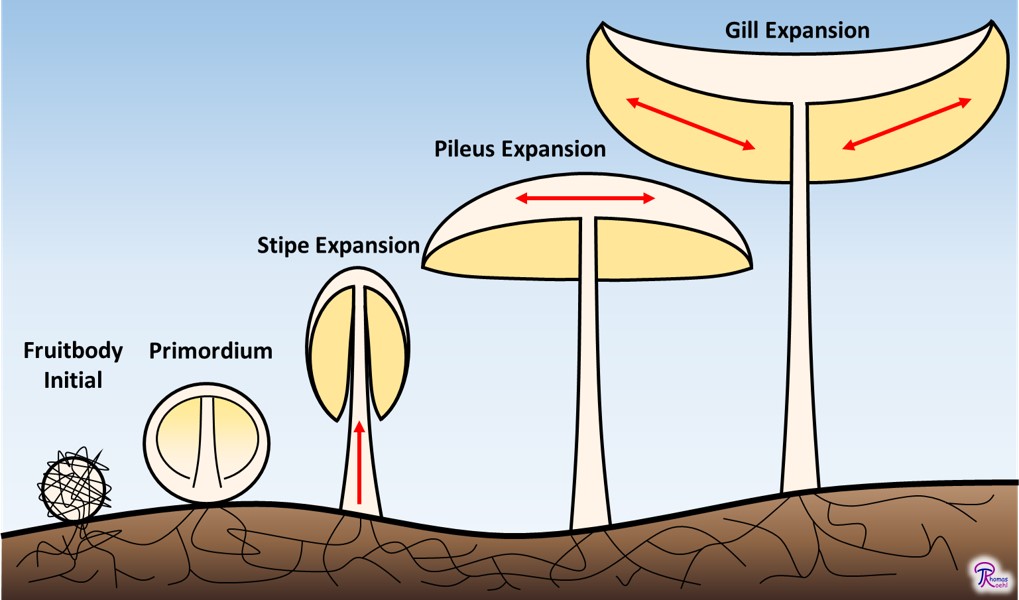
fruitbody initial -> primordium -> expansion.
There are actually a lot of examples of step 3 that you can see in nature. Amanita muscaria (FFF#069) is one of the best. When that mushroom’s universal veil breaks apart, it leaves small warts on the pileus. Just after breaking apart, the warts are very close together. As the cap gets larger, however, the warts become evenly spread out over the cap surface. This indicates that cells throughout the pileus are getting larger. You could easily recreate this by putting pieces of paper on a balloon and inflating the balloon: the paper pieces would spread apart evenly. This also demonstrates that new tissue is not being added to the cap. If tissue was being added at the pileus margin, the warts would remain tightly packed over the middle of the cap as the mushroom got bigger. If tissue was being added in the middle, the warts would spread away from the center to end up in a doughnut shape.
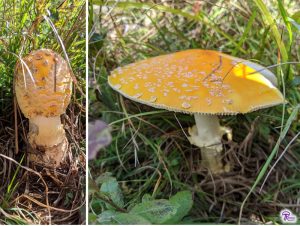
Even though Amanita provides us with evidence to support this model, it does not apply in all cases. Consider what would happen if you inflate a balloon with a bunch of other balloons nearby. The new balloon would simply push all the other balloons out of the way. Similarly, this is the outcome predicted by the basic developmental model: because mushroom growth after the primordial stage is driven by inflating hyphae, the mushroom should push aside anything in its way. Indeed, this outcome is seen in many gilled mushrooms. But, another outcome happens in some mushrooms, such as polypores: nearby mushrooms fuse with one another. The basic developmental model cannot explain what happens in those cases, because there is no way to make two balloons fuse with each other just by inflating them.
Determinate Growth, Indeterminate Growth, and Haptomorphosis
So, why doesn’t the basic model of development apply to all mushrooms? Well, mycologists actually recognize two major types of development in mushrooms: determinate growth and indeterminate growth. [Oddly, these terms are not defined in the context of mushroom development anywhere in the mycological literature, even though mycologists take them for granted.] The basic developmental model was created after studying gilled mushrooms,1 which use determinate growth. It is no surprise, then, that the model applies to determinate growth mushrooms but not to indeterminate growth mushrooms.
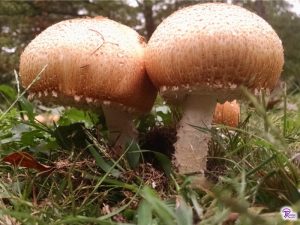
Determinate growth can be recognized when the mushroom pushes aside debris and other nearby mushrooms. Gilled mushrooms are good examples of determinate growth: amanitas push dirt out of the way when they burst through the soil; Oyster Mushrooms (FFF#021), Enoki (FFF#071), and Honey Mushrooms (ex: FFF#198) often grow in dense clusters but their caps are always easy to separate from one another. Pushing aside nearby objects is a consequence of growth by cell inflation, which is the backbone of the basic developmental model.
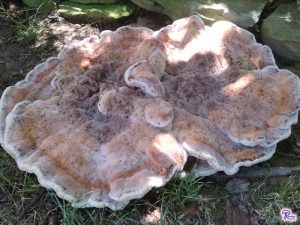
Indeterminate growth can be recognized when mushrooms incorporate debris into their fruiting bodies or fuse with the mushrooms around them. Many polypores exhibit this type of growth: Turkey Tail mushrooms often fuse with one another to cover the surface of a log; Phaeolus schweinitzii (FFF#201) and Inonotus dryadeus, since they grow close to the ground, usually have leaves, sticks, and blades of grass sticking right through the mushrooms. My most disappointing mushroom find was a Hen of the Woods (FFF#103) that looked perfect from the outside but was inedible due to a layer of sand embedded just below the undersurface. Recent rain had splashed the sandy soil onto the bottom of the mushroom and, because it was an indeterminate growth mushroom, the pore surface grew right over top of the sand. With the sand fully embedded in the mushroom, there was no way to remove it and I eventually realized I had to toss the whole mushroom.
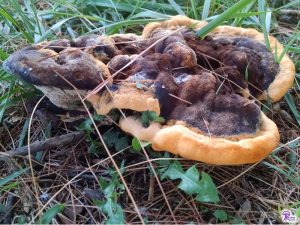
The tendency of indeterminate growth mushrooms to grow around or engulf debris has its own special term: haptomorphosis.2 Haptomorphosis translates to “the process of shaping by touch” and is again often seen in polypores. I personally don’t find this term very useful because haptomorphosis seems to be a simple consequence of indeterminate growth. (However, I plan on studying the phenomenon in more detail because I think it has something important to tell us about mushroom development.)
Growing around obstacles and fusing with nearby mushrooms are both actions that indicate new cells are forming on the outside of the mushrooms. Rather than simply inflating existing tissues, indeterminate growth fungi add new tissue to the mushroom as they grow. Adding new tissue is not accounted for in the basic developmental model, so the model cannot be applied to indeterminate growth mushrooms.
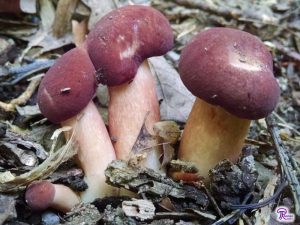
Even the determinate/indeterminate growth categorization system has its limitations: there are many examples of mushrooms that don’t quite fit into either group. For example, you often find boletes that have pushed aside debris but have fused pilei, demonstrating some features of each type of growth. Furthermore, some mushrooms seem to use different types of growth in different parts of their fruitbodies. Gyromitra brunnea (FFF#232) usually has a lot of dirt embedded in its stipe, but the cap pushes nearby things out of the way. Does it start off using indeterminate growth in its stipe and then switch to determinate growth in the pileus? Unusual growth patterns like those have never been studied from a developmental standpoint, so we really have no idea what’s going on.
Developmental Biology
In order to get past the limitations of those models and discuss mushroom development more broadly, it would help to take some cues from the field of developmental biology. Developmental biologists focus on processes or mechanisms that drive development, instead of specific sequences of events. Taking a similar approach with mushroom development would make it easier for mycologists to apply what we know to species that don’t fit the basic model. An updated model of mushroom development might look something like this:
- Initiation: the fungus begins the process of mushroom formation at a specific point based on external signals. In gilled mushrooms, this results in a fruitbody initial.
- Pattern Formation: different tissues are established in different areas of the mushroom. In gilled mushrooms, this takes place in the primordium.
- Growth: the patterns are expanded until the mushroom reaches its mature size. Determinate growth mushrooms primarily use cell expansion, while indeterminate growth mushrooms primarily use cell division.
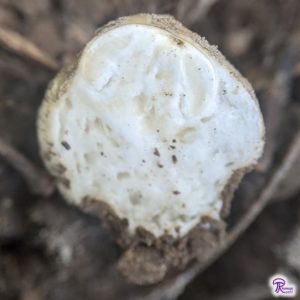
By focusing on the process of growth in step 3 (instead of the event of cell expansion), the model is able to include determinate and indeterminate growth. Both types of development result in the mushroom getting bigger – they only differ by the mechanisms used to accomplish that growth. In this way, a process-oriented model will allow mycologists to include more types of mushrooms in the study of development and ultimately expand our knowledge of the field.
Mushroom development research would also benefit from embracing additional concepts from developmental biology. Coming up next week, I will go into more detail on how developmental biology helps us understand and research mushroom development.
See Further:
Unfortunately, there aren’t very many resources on mushroom development. The best resource is probably the book Fungal Morphogenesis by David Moore, even though it was published in 1998 and completely ignores indeterminate growth. https://www.cambridge.org/core/books/fungal-morphogenesis/7C2A0DF3BB8D6FAA7D769AB9304D2964
Although it doesn’t ever discuss mushroom development, the movie Fantastic Fungi is another good resource. It has some excellent time-lapse photography that highlights growth by cell expansion in gilled mushrooms, growth by adding tissue in Ganoderma lucidum, and… whatever Hericium erinaceus is doing. (Also keep your eyes peeled for the hypersensitive response as strawberry cells die just before a zygomycete spreads over them – not development, but still a cool phenomenon!) https://fantasticfungi.com/







![#011: Characteristics of Kingdom Fungi [Archived]](https://www.fungusfactfriday.com/wp-content/themes/hueman/assets/front/img/thumb-small-empty.png)

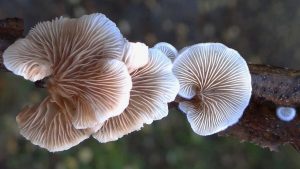
2 Responses
[…] the largest and most interesting of the complex structures formed by fungi. In my previous post (FFF#234), I summarized what we know about mushroom development. Today, I will go into more detail on the […]
[…] the largest and most interesting of the complex structures formed by fungi. In my previous post (FFF#234), I summarized what we know about mushroom development. Today, I will go into more detail on the […]